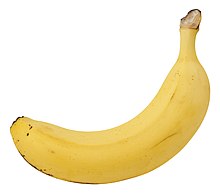バナナ等価線量

バナナ等価線量[1](バナナとうかせんりょう、英: Banana Equivalent Dose, BED)は、放射線被曝量を表す非公式な指標。バナナには天然放射性同位体、特に天然に存在するカリウムの同位体のひとつであるカリウム40 (40K)が含まれている。バナナ等価線量はバナナを1本食べたときに受ける線量を表すもので[2]、およそ0.1マイクロシーベルトに相当するとされる[3]。しかし、実際には代謝によって体内のカリウム40の量は平衡に保たれるため、バナナを食べることによって被曝線量が増加することはない[4]。バナナ等価線量は非常に低レベルの放射能が自然食品中に存在することを一般公衆に知らせることのみを目的としており、線量測定に正式に採用されているわけではない。
歴史[編集]
この概念の起源は定かではないが、初期の言及のひとつとして、1995年のRadSafe原子力安全メーリングリストにおいてローレンス・リバモア国立研究所のGary Mansfieldが「バナナ等価線量」が「一般公衆に極低線量被曝(そしてそれに対応する微小なリスク)について説明しようとするときに非常に有用」であるとわかったと述べている[5]。ここでは9.82×10−8シーベルトつまり約0.1マイクロシーベルトを150グラムのバナナに相当するとみなすことが提案された。
化学者の山崎昶はバナナ等価線量について「もともとは英国のBBCの記事から始まった」、「ジョーク半分に定められた単位だったのに、いつの間にか市民権を得た」としている[1]。
有用性[編集]
放射線のリスクは専門的知識のない一般人には評価が難しいものだが、バナナ等価線量に換算して表示することが、リスクの程度を直感的なイメージとして伝えるのに役立つことがある[6]。また、ごく微量の放射線は日常生活のあらゆるところに存在しているということや、微量であれば全く害のない普通の物質であっても、大量に摂取すれば重大な健康リスクになりうるということを示す意味でも、バナナ等価線量は有用だとされる[3]。
批判[編集]
バナナを摂食することによってカリウムによる被曝が増えることはないため、バナナ等価線量は欠陥のある概念であるといくつかの情報源で指摘されている[7][8][4]。
体内のカリウム(そして40K)の量はホメオスタシスによってほぼ一定に保たれており[9][10]、 食物から吸収された過剰量と同等の量がすぐに排泄される[5][7]。
バナナを摂食したことによる線量の増加が持続するのは、腎臓によって体内のカリウム量が正常に戻されるまでのわずかな時間のみである。これに対して、EPAの換算係数は純粋な40Kの摂取後に体内のカリウム同位体比が天然同位体比に戻るまでに要する時間に基づいており、生物学的半減期はEPAによると30日とされている[9]。
通常人体には1kg当たり2.5gのカリウムが含まれている[11]。人体が持つカリウムによる放射能は、体重60kgの成人男子で約4000Bqであり、これによる年間の内部被曝線量は、0.17ミリシーベルト(mSv)となる。
脚注[編集]
- ^ a b 山崎 昶『化学はこんなに役に立つ : やさしい化学入門』裳華房、2013年11月、129頁。ISBN 978-4-7853-3096-5。
- ^ XRayCeRT Understanding Ionizing Radiation and Protection 2014年 p.123
- ^ a b Michael Blastland "Go Figure: What bananas tell us about radiation" BBC News Magazine 2011年10月13日
- ^ a b Paul Frame, General Information About K-40, Oak Ridge Associated Universities. Accessed 26 December 2017.
- ^ a b RadSafe mailing list: original posting and follow up thread. FGR11 discussed.
- ^ XRayCeRT Understanding Ionizing Radiation and Protection 2014年 p.54
- ^ a b Maggie Koerth-Baker (2010年8月27日). “Bananas are radioactive—But they aren't a good way to explain radiation exposure”. 2011年5月25日閲覧。. Attributes the title statement to Geoff Meggitt, former UK Atomic Energy Authority.
- ^ Gordon Edwards, "About Radioactive Bananas", Canadian Coalition for Nuclear Responsibility. Accessed 26 December 2017.
- ^ a b U. S. Environmental Protection Agency (1999), Federal Guidance Report 13, page 16: "For example, the ingestion coefficient risk for 40K would not be appropriate for an application to ingestion of 40K in conjunction with an elevated intake of natural potassium. This is because the biokinetic model for potassium used in this document represents the relatively slow removal of potassium (biological half-time 30 days) that is estimated to occur for typical intakes of potassium, whereas an elevated intake of potassium would result in excretion of a nearly equal mass of natural potassium, and hence of 40K, over a short period."
- ^ Eisenbud, Merril; Gesell, Thomas F. (1997). Environmental radioactivity: from natural, industrial, and military sources. Academic Press. pp. 171–172. ISBN 978-0-12-235154-9. "It is important to recognize that the potassium content of the body is under strict homeostatic control and is not influenced by variations in environmental levels. For this reason, the dose from 40K in the body is constant."
- ^ Thomas J. Glover, comp., Pocket Ref, 3rd ed. (Littleton: Sequoia, 2003), p. 324 (LCCN 2002-91021), which in turn cites Geigy Scientific Tables, Ciba-Geigy Limited, Basel, Switzerland, 1984.
